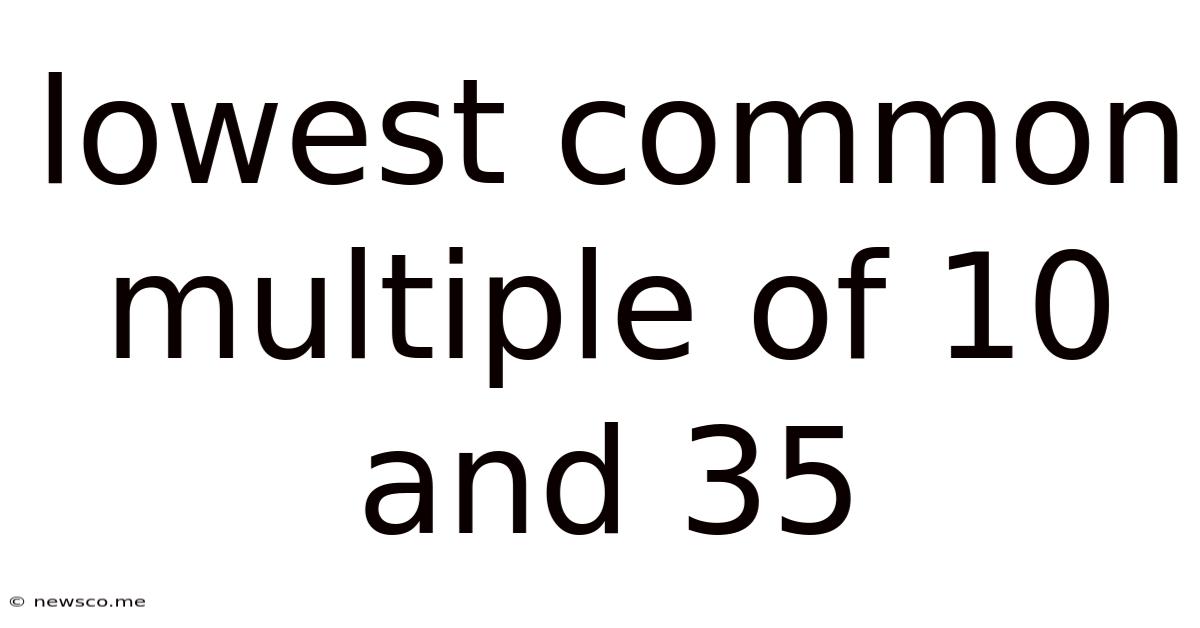Lowest Common Multiple Of 10 And 35
News Co
Apr 18, 2025 · 5 min read

Table of Contents
Finding the Lowest Common Multiple (LCM) of 10 and 35: A Comprehensive Guide
Finding the lowest common multiple (LCM) is a fundamental concept in arithmetic with wide-ranging applications in various fields, from scheduling to engineering. This comprehensive guide will delve into the methods of calculating the LCM of 10 and 35, explore the underlying mathematical principles, and discuss practical applications of this concept. We'll go beyond a simple answer and provide a deep understanding to ensure you can tackle similar problems with confidence.
Understanding the Lowest Common Multiple (LCM)
The lowest common multiple (LCM) of two or more integers is the smallest positive integer that is divisible by all the integers. It's the smallest number that contains all the numbers as factors. Understanding this definition is crucial before we start calculating the LCM of 10 and 35.
Distinguishing LCM from Greatest Common Divisor (GCD)
It's important to differentiate the LCM from the greatest common divisor (GCD). The GCD is the largest positive integer that divides each of the integers without leaving a remainder. While both concepts deal with factors and divisibility, they represent opposite ends of the spectrum. The LCM finds the smallest common multiple, while the GCD finds the largest common divisor.
Methods for Calculating the LCM of 10 and 35
There are several ways to find the LCM of 10 and 35. Let's explore the most common and effective methods:
1. Listing Multiples Method
This method involves listing the multiples of each number until we find the smallest common multiple.
- Multiples of 10: 10, 20, 30, 40, 50, 60, 70, 80, 90, 100...
- Multiples of 35: 35, 70, 105, 140...
By comparing the lists, we can see that the smallest number present in both lists is 70. Therefore, the LCM of 10 and 35 is 70. This method is straightforward for smaller numbers but becomes cumbersome for larger numbers.
2. Prime Factorization Method
This method is more efficient, especially for larger numbers. It involves finding the prime factorization of each number and then constructing the LCM using the highest powers of each prime factor.
- Prime factorization of 10: 2 × 5
- Prime factorization of 35: 5 × 7
To find the LCM, we take the highest power of each prime factor present in either factorization:
- Highest power of 2: 2¹ = 2
- Highest power of 5: 5¹ = 5
- Highest power of 7: 7¹ = 7
Multiplying these together: 2 × 5 × 7 = 70. Therefore, the LCM of 10 and 35 is 70. This method is generally preferred for its efficiency and scalability.
3. Using the Formula: LCM(a, b) = (|a × b|) / GCD(a, b)
This method utilizes the relationship between the LCM and the GCD. First, we need to find the GCD of 10 and 35.
- Factors of 10: 1, 2, 5, 10
- Factors of 35: 1, 5, 7, 35
The greatest common factor of 10 and 35 is 5. Now, we can use the formula:
LCM(10, 35) = (10 × 35) / GCD(10, 35) = (350) / 5 = 70
Therefore, the LCM of 10 and 35 is 70. This method requires calculating the GCD first, but it provides a concise and mathematically elegant solution.
Practical Applications of LCM
The concept of LCM finds practical applications in various real-world scenarios:
1. Scheduling and Time Management
Imagine two buses that depart from the same station. One bus departs every 10 minutes, and the other departs every 35 minutes. The LCM helps determine when both buses will depart simultaneously again. In this case, the LCM of 10 and 35 (70 minutes) indicates that both buses will depart together again after 70 minutes, or 1 hour and 10 minutes.
2. Fraction Operations
The LCM plays a crucial role in adding and subtracting fractions with different denominators. To add fractions like 1/10 and 1/35, we need to find a common denominator, which is the LCM of 10 and 35 (70).
3. Gear Ratios and Mechanical Engineering
In mechanical systems with gears, the LCM helps determine the synchronization of different gears with varying numbers of teeth. Understanding the LCM ensures smooth and efficient operation.
4. Cyclic Patterns and Repetition
Many real-world phenomena exhibit cyclical patterns or repetitions. The LCM helps predict when these cycles will align or coincide. This is useful in various fields like physics, astronomy, and computer science.
Advanced Concepts and Extensions
While we've focused on finding the LCM of two numbers, the concept extends to multiple numbers. The methods described above can be adapted to calculate the LCM of three or more integers. For instance, to find the LCM of 10, 35, and 15, we'd extend the prime factorization method to include all three numbers.
Conclusion: Mastering LCM Calculations
Understanding the lowest common multiple is essential for a strong foundation in mathematics and its applications. We've explored three distinct methods for calculating the LCM, highlighting their strengths and weaknesses. Mastering these methods allows you to solve a wide array of problems efficiently and effectively, regardless of the size of the numbers involved. The practical applications of LCM extend far beyond basic arithmetic, playing a significant role in diverse fields, underscoring the importance of grasping this concept thoroughly. Remember, practice is key to mastering any mathematical concept, so tackle various problems to solidify your understanding. This deep dive into LCM calculations equips you with the knowledge and skills to tackle related problems confidently and efficiently.
Latest Posts
Related Post
Thank you for visiting our website which covers about Lowest Common Multiple Of 10 And 35 . We hope the information provided has been useful to you. Feel free to contact us if you have any questions or need further assistance. See you next time and don't miss to bookmark.